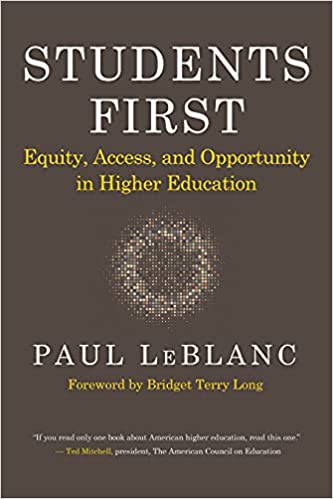You have /5 articles left.
Sign up for a free account or log in.

Students First: Equity, Access, and Opportunity in Higher Education by Paul LeBlanc
Published in October 2021
In Students First, Paul LeBlanc argues that higher education fulfills two fundamental missions:
- to create new knowledge, basic research, and breakthroughs that deepen our understanding of the world and fuel human progress
- to unlock opportunity and social mobility to allow people to improve their lives and the lives of their families and communities
—page 167
I love this definition of what we do in academia.
Students First is all about the second of these intertwined missions. LeBlanc, president of Southern New Hampshire University, has written a book that all of us invested in the idea that a university education is an engine of opportunity creation should read.
(Disclosure: Paul LeBlanc has been a generous, steadfast and continuous supporter of my academic career over the years—and is a beloved colleague to a great many of us across the postsecondary ecosystem.)
The central argument running through Students First is that the underlying credit-hour system on which higher education is structured, financed and operated is poorly designed to meet the needs of most learners. In higher education, we hold time constant (a semester or term ends when it ends) while allowing learning to be variable.
A system of credentialing based on time, with a typical undergraduate degree requiring 120 credit hours earned through passing roughly 40 three-credit courses, can work well for some traditional residential learners. The undergraduate experience for an 18- to 22-year-old is as much about the experiential aspects of living in a community away from home as it is about learning.
However, that traditional residential experience applies only to 13 percent of all undergraduates. In a world where over 80 percent of students commute or learn online and 43 percent of full-time students work, a higher education system based on time makes little sense.
Students First provides a concise and clear explanation of how the U.S. higher education system came to be designed and financed around time, with the credit hour as the core building block in which the system has evolved.
LeBlanc also provides perhaps the most straightforward explanation that I’ve read on how U.S. higher education is financed and regulated at the federal and state levels, the role of accreditors, and the outcomes of this system as measured by levels of student attrition and debt. Students First, however, is not content to diagnose the many shortcomings and failures of our postsecondary system.
If the disease of higher education is that we’ve built a system that relies upon time, the cure is to change the design to place learning at the center.
How might we move to a system where learning is held constant and time is variable? The answer, argues LeBlanc, is to prioritize competencies over other measures such as seat time and grades.
Competency-based education (CBE), as LeBlanc allows, is not a new idea. But it may be an old idea whose time has finally come. Learning science and educational technologies have matured to a place where it is now possible to design instructional environments and assessments capable of building and measuring competencies across the full range of academic disciplines.
One of the great things about Students First is that LeBlanc is not making theoretical arguments for an imagined future. Instead, he draws deeply on the experiences of his own institution’s design of competency-based degrees through SNHU’s College for America. The book also contains excellent descriptions of other universities designed around CBE, such as Western Governors University.
While LeBlanc sees a path forward to redesign rules around federal loans, Pell Grants and accreditation around competencies instead of credit hours, he is clear-eyed about the complexities of changing a system as large and regulated as U.S. higher education.
Instead of arguing for a wholesale change in how universities are financed and run, LeBlanc is asking for space for experimentation. Evolving our teaching, learning and postsecondary financing system will require a commitment to innovation and iteration.
For LeBlanc, the necessity to at least start to move higher education from the credit hour to a system based on competencies is as clear as our eventual need to move away from fossil fuels and towards renewable.
In the long term, a higher education system that only graduates 62 percent of public institution students and 68 percent of private nonprofit institutions while leaving the average student over $30,000 in debt is neither sustainable nor desirable.
Students First provides every college and university a road map to begin small-scale experiments in competency-based education while also providing a framework for the large-scale policy, financing and accreditation changes that would need to occur to bring this reform to scale.
Paul LeBlanc has written a book that all of us in higher education, including those of us at traditional research-intensive residential institutions, will benefit from immeasurably.
What are you reading?




